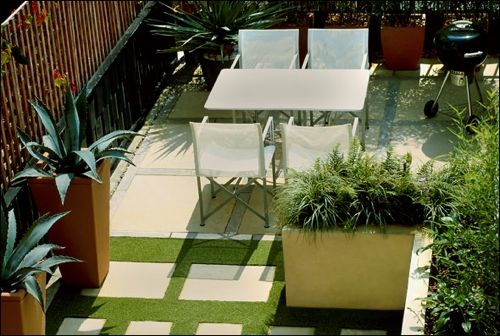Roof Gardens and Balconies

If your only outside space is a roof or balcony, you face some pretty specific gardening challenges. Assuming that you’ve done all the structural checks, and you know that you’re allowed to put containers on your balcony or roof terrace, then what are the main issues and considerations in your choice of plants and containers?
1) Wind scorch and screens
A roof terrace or balcony are pretty exposed areas, especially compared to a ground-level garden. Of course it depends how high you are, but even on the first or second floors, your plants will be exposed to wind and weather, and therefore to suffer from wind scorch and to dry out. So it’s worth thinking about how you might be able to screen your garden a little. A trellis on the side of the prevailing wind, with some tough climbers or fronted by conifers, will provide much-needed respite for you and your plants.
2) Choosing containers
Since you’re only going to be gardening in containers, it pays to put a little thought into your choices to make sure they look good. The two key practical issues are weight and tendency to dry out. Terracotta looks lovely, but is both heavy and has a tendency to dry out. So plastic or galvanised steel are better, as they are lighter and less porous.
You want a variety of sizes of containers: all small will look a bit ridiculous, as well as drying out very fast. If you can afford it, get at least a couple of big ‘statement’ containers that you can fill with multiple plants. And use broken up polystyrene plant containers at the bottom of your containers to improve drainage, as they are considerably lighter than crocks.
3) Choosing a suitable growing medium
Because multi-purpose compost tends to dry out quite quickly, you may be better off with a loam-based compost, or even top soil, perhaps mixed with water-retaining granules. If weight is a real issue for your space, some specialist compost and topsoil suppliers can supply lightweight growing media.
4) Ongoing care
Your containers and pots will need watering, quite probably every day in summer. If you’re busy, or you don’t want to commit to spending the time on watering, then it’s best to invest in an irrigation system. You can buy these from garden centres, and they are usually available as a ‘starter kit’ which is likely to have all you need for a small outside space.
You will also need to feed your containers regularly, even if you start off with slow release plant food in the soil (see our organic soil improver). And with perennial plantings or shrubs, you will need to repot your plants every few years.
